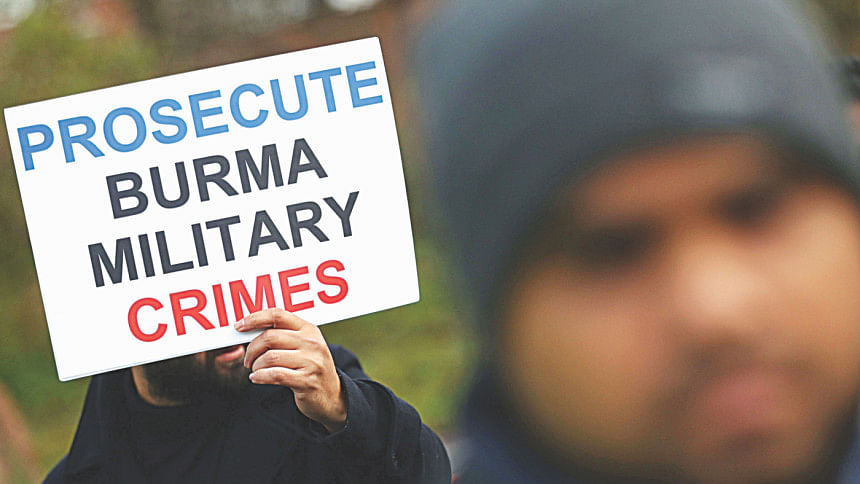The misleading claims

Suu Kyi: Please allow me to clarify the term clearance operation. Its meaning has been distorted. As early as the 1950s has been used against communists. It simply means to clear an area of insurgents or terrorists.
What we found: The so-called clearance operations were not only about clearing an area of insurgents or terrorists. According to the UN Fact-Finding Mission report, there was ample evidence that clearance operations also targeted civilians. For instance, in Tulatoli village, attackers wearing military uniforms indiscriminately shot Rohingya men and methodically killed the survivors, including the children. Furthermore, “Largescale gang rape was perpetrated by Tatmadaw soldiers in at least 10 village tracts of northern Rakhine State,” found the report.
Suu Kyi: Can there be genocidal intent in an establishment that punishes its officers for wrongdoings? ... Accountability through domestic system is the norm. Only when domestic systems fail, can an international criminal justice take place.
What we found: Indeed, the “domestic systems” had failed. For example, in the only instance of accountability by “domestic systems”, seven soldiers were court martialled in August 2018 for the Inn Dinn massacre, where 10 Rohingya men and boys were killed by the soldiers. The soldiers were then granted a military pardon and released after serving less than one year of their 10-year sentence. Two Reuters reporters who reported the incident were jailed for 14 years.
Suu Kyi: We are, however, dealing with an internal armed conflict started by coordinated and comprehensive attacks by ARSA to which Myanmar’s defence services responded. Tragically, this armed conflict led to the exodus of several hundred thousand Muslims from three northern-most townships of Rakhine, to Bangladesh.
What we found: The claim that the exodus is down to the insurgency is “incomplete” and “misleading”. On August 25, 2017, the ARSA attacked 30 police outposts in Maungdaw, killing 12 members of the security forces, and having 59 of their own members killed. There was a similar attack on Hpaung Taw Pyin in Buthidang, where two security officers were killed. But Myanmar responded by summarily attacking Rohingya villages and executing thousands including children and infants. The UN Fact Finding Mission’s report stated that “They continued for more than two months, and for a considerable period after the Government claimed their completion on 5 September 2017.” This is what led to the exodus and those who fled violence in Myanmar have on numerous occasions said they did it to escape the military crackdown.
William Schabas: On several occasions, the court is told the number of buildings and villages destroyed. yesterday the counsel told us of many hundreds of deaths in 3 villages totalling a little more than 1000. They tried to put this as a representative sample -- but these were three of the worst cases.
What we found: The claim that only three villages had been burnt is untrue. Human Rights Watch analysed satellite imagery and found that as many as 354 villages in Maungdaw, Buthidaung, and Rathiduang were partially or completely destroyed between August 25, 2017 and the end of that year. The destruction continues to this year with Al Jazeera reporting in July that “40 percent of the villages originally identified by the United Nations’ satellite tracking service UNOSAT as burned, damaged or destroyed during the 2017 crisis have since been entirely razed.”
William Schabas: We are told that there are an estimated 10,000 deaths. Every death is tragic but 10,000 out of a population of 1 million suggests something else other than an intent to physically destroy the group.
What we found: The number of deaths cannot be used to prove or disprove intent, but precedence has been set as to their importance. During the genocide case brought to the ICJ by Bosnia and Herzegovina against Serbia and Montenegro, the court in its judgement noted that while the defendant contested the “veracity of certain allegation, and the number of victims, or motives of perpetrators…..it never contested, as a matter of fact, that members of the protected group were indeed killed in Bosnia and Herzegovina.” There is no universally-accepted barometer of how many deaths constitutes a genocide. The number of Rohingyas killed, put at 10,000 by Schabas, is significant because according to the UN, it was achieved in 20 days and this number of Rohingyas killed is not disputed by Myanmar.
[Compiled by Zyma Islam, Osama Rahman and Maliha Khan]


 For all latest news, follow The Daily Star's Google News channel.
For all latest news, follow The Daily Star's Google News channel. 



Comments